Pictorial History
by: Anchi Hoh
(The following is a post by Fentahun Tiruneh, Area Specialist for Ethiopia and Eritrea, African and Middle Eastern Division.)
In Ethioipia today, few figures are as revered as Menelik II (1844-1913), the second-to-last reigning monarch of Ethiopia. Like Menelik I of the 10th century BC, the legendary son of King Solomon from whom he took his regal name, Menelik II traced his descent to the Solomonic line of kings. But it is his role in the history of Ethiopia for which Menelik II is most revered to this day, for it was he who defeated a European nation – Italy – on the field of battle, to defend Ethiopian independence.
Menelik II was crowned King of Kings and Emperor of Ethiopia on November 3, 1889, with the additional royal sobriquet of “the Conquering Lion of the Tribe of Judah.” The coronation, which took place in the great Entotto Mariam Church in Addis Ababa, was captured for posterity by the Italian artist Pio Joris (1843-1921) and subsequently reproduced in chromolithograph images, today exceedingly rare. In the painting below, the artist depicted the entire royal entourage in gorgeous color and detail. On the left and right, we see the two leaders of the Ethiopian Orthodox faith: the Archbishop of Alexandria and the Bishop of Ethiopia; the two lions of Judah, traditional symbol of the Solomonic line of kingship; and the “negarit” drums* and the drummers. On the left we see the lesser king and princes congratulating the Emperor, and flanking the Emperor are the various ministers of his cabinet. Among those present during the coronation in the Entotto Mariam Church are Ras Dargie, uncle of Menelik; Dejazmach Dereso, General of the king; Tekle Haimanot, King of Gojjam; Ras Mikael, governor of eastern and parts of southern Wollo; and Ras Mengesha-Atikim, governor of Damot, Agawmeder, Qwarra and adjacent areas.
 Coronation of King of Kings Menelik II. Chromolithograph of the painting by Italian artist Pio Joris in 1890 (Library of Congress African and Middle Eastern Division, Ethiopian Collection).
Coronation of King of Kings Menelik II. Chromolithograph of the painting by Italian artist Pio Joris in 1890 (Library of Congress African and Middle Eastern Division, Ethiopian Collection).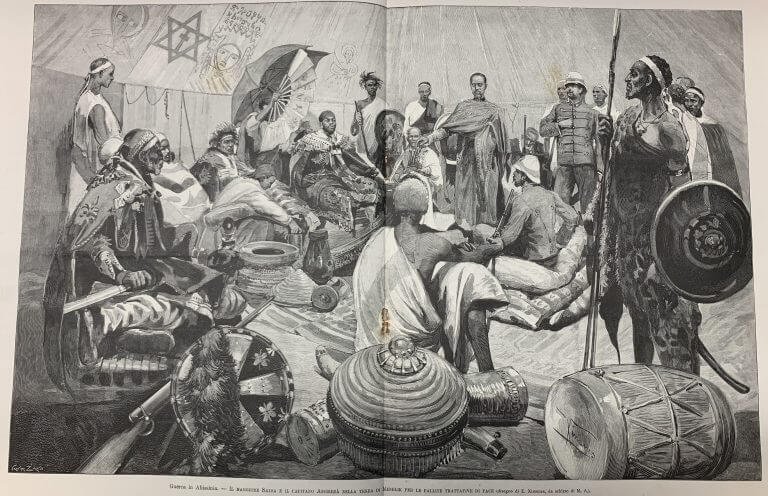 Illustration published in “L’Illustrazione Italiana,” after a painting by the artist E. Zemenes, 1889 (Library of Congress African and Middle Eastern Division, Ethiopian Collection).
Illustration published in “L’Illustrazione Italiana,” after a painting by the artist E. Zemenes, 1889 (Library of Congress African and Middle Eastern Division, Ethiopian Collection).The illustration seen here commemorates the Wuchale Peace Treaty May 1889, by which the King sought to come to an agreement with Italy and avert warfare. In the upper left-hand corner we see a Star of Solomon with a cross in the middle; two important symbols signaling the marriage between the Old and New Testament in Ethiopian culture. The peace talks failed, however, and ultimately led to the famous Battle of Adwa.
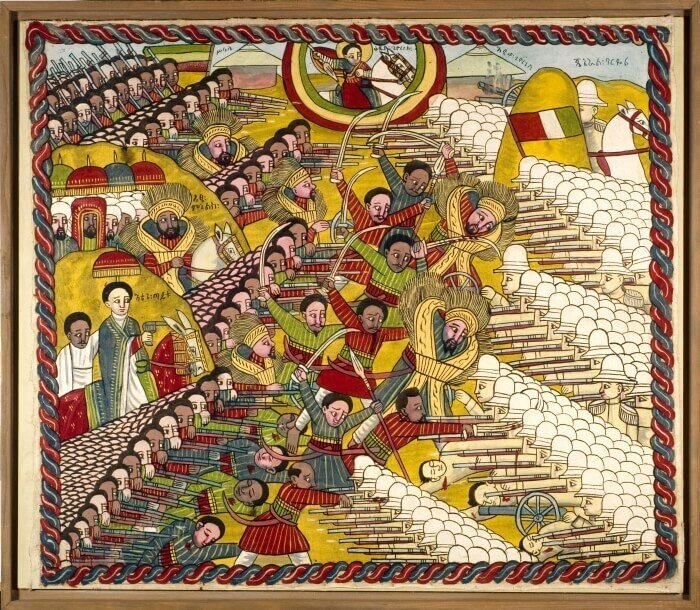 The Battle of Adwa as painted by Shibru Nuru, 1975 (Library of Congress African and Middle Eastern Division, Ethiopian Collection).
The Battle of Adwa as painted by Shibru Nuru, 1975 (Library of Congress African and Middle Eastern Division, Ethiopian Collection).The year 1896 was a crucial year for Europe as a whole, and for Italy in particular. In that year, Italy was defeated by Ethiopia at the Battle of Adwa, signaling the end of the “might is right” era assumed by the European powers of the day. The defeat of the Italians was a major blow to the industrial world because it heralded the beginning of resistance against the industrial powers and the struggle for independence by the colonized African nations. In the painting shown here, St. George appears at the very apex, a reference to the proverbial Ethiopian belief that the Italians were defeated thanks to divine intervention. The drums used to herald the coronation of the King of Kings here become the battle drum that reverberates through the hills of Adwa, shaking the morale of the enemy.
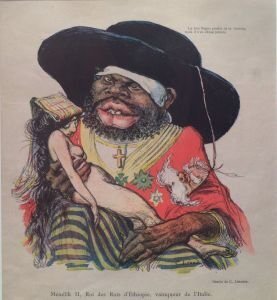 Menelik II by Charles Leandre (1864-1922) (Library of Congress African and Middle Eastern Division, Ethiopian Collection).
Menelik II by Charles Leandre (1864-1922) (Library of Congress African and Middle Eastern Division, Ethiopian Collection).Not surprisingly, some European artists rushed to the defense of colonialism. French artist Charles Leandre,) painted the caricature of Menelik that we see above. At the top right the artist wrote, “The benevolent Negus [i.e., King] takes advantage of the victory, but he never abuses it.” The underlying message, of course, is that the “beastly” and “barbarian” king is going to shame Europe (i.e., Italy), here represented by the helpless, naked woman.
In the aftermath of the war, Pope Leo XIII and King Menelik exchanged letters to effect the release of Italian Prisoners of War, and the Vatican turned to the Church of Alexandria for help with mediation. Trade cards of the day reflect current event in brightly colored images. Here we see Monsignor Macaire of the vicar of the Egyptian Coptic Church approaching Emperor Menelik on behalf of the Pope of Rome; a prudent example of religious diplomacy since the King of Kings and Monsignor Macaire both belonged to the Orthodox faith.
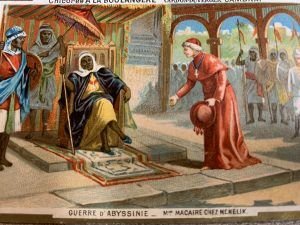 Monsignor Macaire of the vicar of the Egyptian Coptic Church approaching Emperor Menelik on behalf of the Pope of Rome. 1896 (Library of Congress African and Middle Eastern Division, Ethiopian collection of Trade Cards).
Monsignor Macaire of the vicar of the Egyptian Coptic Church approaching Emperor Menelik on behalf of the Pope of Rome. 1896 (Library of Congress African and Middle Eastern Division, Ethiopian collection of Trade Cards).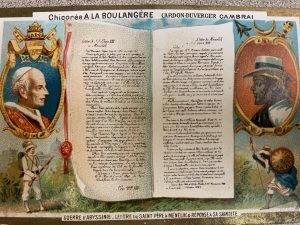 Letter from the Holy Father Leon XIII to Menelik and his reply to his Holiness. (Library of Congress African and Middle Eastern Division, Ethiopian Collection of Trade Cards.)
Letter from the Holy Father Leon XIII to Menelik and his reply to his Holiness. (Library of Congress African and Middle Eastern Division, Ethiopian Collection of Trade Cards.)Negotiations between the two dignitaries bore results. On November 20, 1896, the Emperor released 200 Italian POWs in honor of the Queen of Italy’s birthday, and successive releases were effected in February and June of 1897, when the last of the Italian POWs left the country.

The Battle of Adwa and Its Legacy
Every year in March, Ethiopians celebrate their victory at the Battle of Adwa. The hero of that battle, Menelik II, remains a venerated figure in Ethiopian society, and indeed worldwide.

In marked contrast to the caricature shown above, Emperor Menelik II was often depicted as a noble and dignified figure in the art of his own time, as we see in this Trade Card here:

The King’s call for arms against Italy resonates powerfully to this day:
Now an enemy that intends to destroy our homeland and change our religion has come crossing our God-given frontiers. Now, with the help of God I will not allow him to have my country. You, my countrymen, I have never knowingly hurt you, nor have you hurt me. Help me, those of you with zeal and will power; those who do not have the zeal, for the sake of your wives and your religion, help me with your prayers. (Gebre Selassie, Tarika zaman Zadagmawi Menilek Negusa Nagast ZeItyopya, 1966, p. 225.)
Menelik’s wife, the Princess Taitu, also commands respect in popular memory, and is often depicted as falling to her knees in prostration when the battle began and praying for victory. It was she who warned the Emperor about suspicious activities on the part of the Italian emissaries, scenting out political ploys under the cover of peace negotiations. Most important of all, she played a very strategic role by controlling the sources of water from the enemy.
Sehafe Te’ezaz Gebre Selassie, an eyewitness to the Battle of Adwa, concludes in his memoirs that no matter how organized an army may be, and no matter how sophisticated its arsenal of weapons, victory is only possible through God-given valor and skill. And in the Battle of Adwa, Menelik II proved the moral imperative in the struggle of Ethiopia against colonialism.
For more information resources about this topic at the Library of Congress, contact the African and Middle Eastern Reading Room (AMED) through the AMED’s Ask-a-Librarian inquiry form.
*A “negarit” drum is a special drum beaten to herald the approach of a monarch or the announcement of a decree.
Emperor Menelik II – Abyssinia’s Ruler Said to be a Heavy Buyer of American Railway Stocks

Menelik was an Oromo from the then Oromo province of Shoa (sheger) who rose to power with his strong army of Oromo base and resources. He usurped or stole the imperial power from the rightful inheritors of the throne (successors of Emperor Yohannes of Tigray). Because of the Amhara intrigues the Tigray inheritors lost the throne But after he expanded his empire and consolidated his power as an emperor, he took an Amhara identity and lives as such until his death.